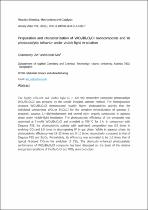 ResearchSpace
ResearchSpace
Preparation and characterization of WO3/Bi3O4Cl nanocomposite and its photocatalytic behavior under visible light irradiation
JavaScript is disabled for your browser. Some features of this site may not work without it.
- ResearchSpace
- →
- Research Publications/Outputs
- →
- Journal Articles
- →
- View Item
| dc.contributor.author |
Chakraborty, AK

|
|
| dc.contributor.author |
Kebede, Mesfin A

|
|
| dc.date.accessioned | 2013-03-25T07:14:12Z | |
| dc.date.available | 2013-03-25T07:14:12Z | |
| dc.date.issued | 2012-01 | |
| dc.identifier.citation | Chakraborty, AK and Kebede, MA. 2012. Preparation and characterization of WO3/Bi3O4Cl nanocomposite and its photocatalytic behavior under visible light irradiation. Reaction Kinetics, Mechanisms and Catalysis, vol. 106(1), pp 83-98 | en_US |
| dc.identifier.issn | 1878-5190 | |
| dc.identifier.uri | http://link.springer.com/article/10.1007%2Fs11144-012-0423-7# | |
| dc.identifier.uri | http://hdl.handle.net/10204/6624 | |
| dc.description | Copyright: 2012 Springer. This is an ABSTRACT ONLY. The definitive version is published in Reaction Kinetics, Mechanisms and Catalysis, vol. 106 (1), pp 83-98 | en_US |
| dc.description.abstract | The highly efficient and visible light ( = 420 nm) responsive composite photocatalyst WO3/Bi3O4Cl was prepared by the simple incipient wetness method. The heterojunction structure WO3/Bi3O4Cl demonstrated notably higher photocatalytic activity than the individual components WO3 or Bi3O4Cl for the complete mineralization of gaseous 2-propanol, aqueous 1,4-dichlorobenzene and several other organic compounds in aqueous phase under visible-light irradiation. The photocatalytic efficiency of the composite was optimized at 7 mol% WO3/Bi3O4Cl and annealed at 700 °C for 1 h. In comparison with Degussa P25, the photocatalytic activity with optimized composition was 5.9 times in evolving CO2 and 8.8 times in decomposing IP in gas phase. While in aqueous phase, its photocatalytic efficiency was 19–22 times and 9–10 times, respectively, compared to that of Degussa P25 and Bi2O3. Remarkably, its efficiency was estimated to be 1.6 times that of typical N-doped TiO2 in the evolution of CO2. The obviously enhanced photocatalytic performance of WO3/Bi3O4Cl composite has been discussed on the basis of the relative energy band positions of the Bi3O4Cl and WO3 semiconductors. | en_US |
| dc.language.iso | en | en_US |
| dc.publisher | Springer | en_US |
| dc.relation.ispartofseries | Workflow;10393 | |
| dc.subject | Nanocomposites | en_US |
| dc.subject | Photocatalysts | en_US |
| dc.subject | Organic pollutants | en_US |
| dc.subject | CO2 Evolution | en_US |
| dc.title | Preparation and characterization of WO3/Bi3O4Cl nanocomposite and its photocatalytic behavior under visible light irradiation | en_US |
| dc.type | Article | en_US |
| dc.identifier.apacitation | Chakraborty, A., & Kebede, M. A. (2012). Preparation and characterization of WO3/Bi3O4Cl nanocomposite and its photocatalytic behavior under visible light irradiation. http://hdl.handle.net/10204/6624 | en_ZA |
| dc.identifier.chicagocitation | Chakraborty, AK, and Mesfin A Kebede "Preparation and characterization of WO3/Bi3O4Cl nanocomposite and its photocatalytic behavior under visible light irradiation." (2012) http://hdl.handle.net/10204/6624 | en_ZA |
| dc.identifier.vancouvercitation | Chakraborty A, Kebede MA. Preparation and characterization of WO3/Bi3O4Cl nanocomposite and its photocatalytic behavior under visible light irradiation. 2012; http://hdl.handle.net/10204/6624. | en_ZA |
| dc.identifier.ris | TY - Article AU - Chakraborty, AK AU - Kebede, Mesfin A AB - The highly efficient and visible light ( = 420 nm) responsive composite photocatalyst WO3/Bi3O4Cl was prepared by the simple incipient wetness method. The heterojunction structure WO3/Bi3O4Cl demonstrated notably higher photocatalytic activity than the individual components WO3 or Bi3O4Cl for the complete mineralization of gaseous 2-propanol, aqueous 1,4-dichlorobenzene and several other organic compounds in aqueous phase under visible-light irradiation. The photocatalytic efficiency of the composite was optimized at 7 mol% WO3/Bi3O4Cl and annealed at 700 °C for 1 h. In comparison with Degussa P25, the photocatalytic activity with optimized composition was 5.9 times in evolving CO2 and 8.8 times in decomposing IP in gas phase. While in aqueous phase, its photocatalytic efficiency was 19–22 times and 9–10 times, respectively, compared to that of Degussa P25 and Bi2O3. Remarkably, its efficiency was estimated to be 1.6 times that of typical N-doped TiO2 in the evolution of CO2. The obviously enhanced photocatalytic performance of WO3/Bi3O4Cl composite has been discussed on the basis of the relative energy band positions of the Bi3O4Cl and WO3 semiconductors. DA - 2012-01 DB - ResearchSpace DP - CSIR KW - Nanocomposites KW - Photocatalysts KW - Organic pollutants KW - CO2 Evolution LK - https://researchspace.csir.co.za PY - 2012 SM - 1878-5190 T1 - Preparation and characterization of WO3/Bi3O4Cl nanocomposite and its photocatalytic behavior under visible light irradiation TI - Preparation and characterization of WO3/Bi3O4Cl nanocomposite and its photocatalytic behavior under visible light irradiation UR - http://hdl.handle.net/10204/6624 ER - | en_ZA |





